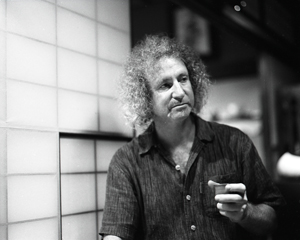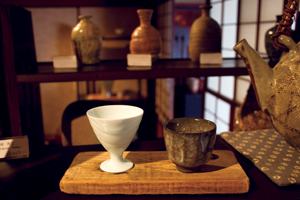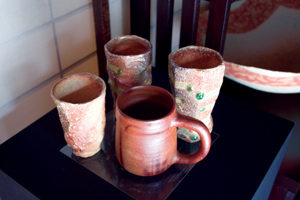Handling History in a Clay Vessel
by Sakamoto Flash

There are few more ancient and revered artistic traditions in Japan than yakimono– the often-mottled, kiln-fired ceramic pottery whose origins predate recorded history and which today draws the interest of museums and collectors from around the world. Naturally, in such an historically rich tradition, there will be experts, people who devote their lives to the appreciation, understanding and sharing of its pleasures and insights. One who many believe to be the foremost expert in the field, certainly when it comes to contemporary ceramic art, is Kyoto-based gallery owner Robert Yellin. While it may seem strange to some that such an individual is not Japanese, Robert has spent nearly thirty years in the field, conducting research by tirelessly visiting studios, meeting some of the living artists and, most importantly, handling the pieces. This tactile relationship with ceramic art is an underemphasized part of experiencing them and Robert is quick to assert its importance. “People are always worried about yakimono because of their expense. What I if break it? Then don’t buy it. All things have their own fate. You have to interact with it.” For most the visual interaction with ceramic vessels provides the greatest satisfaction. Robert’s pieces are all unique and he explains how each is hand crafted, glazed using a variety of techniques, and then fired, leaving the ultimate outcome to the fate of forces in the kiln. Based on these steps, Robert can accurately identify a piece. “Japanese ceramic styles are defined by the clay. Once you determine the clay, you can determine what town it’s from. Even when it’s been glazed, I can turn it over and recognize it. Most are named after the town in which they are fired. The simplicity of the materials is very important: clay, water, fire, air. The only other thing added is the human spirit. Each piece has great energy running through it.” His description may strike some as mystical, exaggerated, even bogus, but it’s easier to understand when you hold a beautiful piece in your hand. They do possess uniqueness, like an afterlife of the artist. Which begs the question, is it art? Shaping vessels out of clay can seem more like a handcraft, and so much of the end-result is a mere consequence of the kiln. “There are two styles of wood-burning kilns. One was introduced in the 5th century, the Anagama, which is single-chambered. Then in the 16th century came the Korean-influenced Noborigama, which is a climbing kiln. When you have a wild, wood-burning kiln, all kinds of crazy things happen beyond the control of the potter. But they can manipulate the results. That’s how you get fascinating glazes and colors. There is interaction between man and nature to create beauty, and to me, this is very profound.” Obviously, it’s profound to many others as well, which explains the fine museums and auction houses specializing in yakimono. Robert has many high-profile clients of his own—world famous celebrities—though he is discrete about their identities. He also notes that you need not be rich to become an aficionado. Some pieces are as affordable as several thousand yen, though they may not possess the complexity and allure of more expensive works. Robert’s own background seems humble for the role he has assumed. “I did a college summer homestay in Mishima, Shizuoka, in 1982 and became fascinated by yakimono. I think my love of food and beverage and Zen and spirituality took me into that world. After college, I went back and was always touching and learning about these objects on my own. I studied a lot of aesthetics and philosophy in college, but my knowledge of ceramic art is all first hand. I trekked all over Japan, visiting kilns and talking to the potters. I attended lectures, but too many of these people have no first-hand knowledge. I’ve been in the field for nearly 30 years and there’s no substitute for that. I really don’t think anyone has handled more Japanese ceramic art than myself. “Even now, I’m still looking. Some of the oldest extant pots in the world were made here; from the Jômon period on, some part of Japan has been firing kilns. It’s a potter’s paradise. The only way to understand them is to live with them.” Years ago I met Robert when he was still based in Mishima. I mistook his passion for a kind of mild aggressiveness. Maybe the two are as inseparable as the swirling green and orange glazes of a piece I bought from him. Either way, his passion is infectious. “You have these beautiful art forms connected to Zen and tea ceremony, and yet you can use them every day. There is a great joy in it.” Finding a satisfying piece is much like love at first sight and can take time and chance. Robert better enables the pairing of clients with a piece by demanding the best. “I acquire a lot of work directly from the artists. I say, I’m going to buy your work, so show me the best you’ve got. For any one kiln firing, only about 10% are exhibition or museum quality, and that’s what I want. That’s what I look for. Now that I’m in Kyoto, I can go deeper and visit more exclusive, dealer-only auctions.” Robert’s recent move to Kyoto seems like an appropriate move for him. His roots are of course in Mishima, but its remoteness prevented some clients from coming. Kyoto has changed that. Now many more people can appreciate his collection and that alone seems to provide him satisfaction, the financial benefits aside. His gallery occupies a beautiful historical home just a few minutes from Ginkaku-ji (Silver Pavilion). After a night on the town– he is still partial to food and beverage, especially craft beer– we sit at a table to appreciate some of his pieces. That means drinking from them. I almost choke on my sake when he casually mentions that I am drinking from a Kamakura-era piece, but then remember his mantra, “if it breaks, then that was the fate of the piece.” Drinking from such a vessel does somehow enhance your appreciation, not only of the piece and the sake, but the gestalt experience: seeing the many colors and shapes glittering beneath the shivering pool of liquid, feeling the incongruous surface on your lips, swallowing. “That particular piece has an unusual shape because the samurai who drank from them wore arm armor that limited their hand and wrist mobility.” For a moment, I imagine myself as a samurai. The sake helps. Robert begins taking pieces from his shelves and showing them to me, some functional, others abstract. He is visibly comfortable with handling such expensive items. “These two are by former national living treasures. I’ve met many over the years: Kato Kozo, Miwa Jusetsu, Isesaki Jun, Fujiwara Yu, Suzuki Osamu, Shimaoka Tatsuzo. The first individuals were designated in 1955, to maintain the arts in Japan. People think the treasure is the person, but it’s not; it’s the technique that they possess, and they are designated to transmit that so traditions can remain alive and thrive.” Yakimono, at least, does thrive. Designations or not, it will continue to with individuals like Robert. But somebody has to hold them and drink from them for the circle to be complete. Those worried about dropping them need not apply. It just wasn’t their fate to discover the deeper beauty. |
焼きものは日本に古くから伝わり、現在でも人気の高い、風流な伝統文化である。その起源は古く有史以前にさかのぼることが出来、今日では世界中の博物館や収集家たちの注目を集めている伝統工芸品となっている。豊かな歴史を持つことから、その普及と一般の人々の焼物に対する理解を深めることに人生を賭けるくらいの専門家が出てくるのも自然の成り行きといえる。この世界の第一人者で、特に現代陶芸の分野では右に出るものがいないとされているのが京都で焼きものギャラリーを運営しているロバート・イエリンである。 外国人?と思う向きもあろうが、彼はすでに陶芸の世界で30年近いキャリアを持ち、各地の陶芸工房を訪問しては調査・研究を続け、また実際に陶芸家たちと会って話をし、自らも陶芸家として活躍してきた。実際に陶磁器に触るということは陶磁器を理解する上でとても重要なことなのだがともすれば軽視されがちだという。ロバートは陶磁器に触れることの重要性を説く。 「高価なもののだからと怖がって触ろうとしない人が多いのです。買う気も無いものを壊したりしたら大変だというのです。しかしあらゆるものにはそれぞれに運命というものがあります。重要なのは陶磁器に触れて心を通わせることです」。 陶磁器を鑑賞して心を通わせることは大きな満足感をもたらす。ロバートの作品はどれも個性的で、彼はひとつひとつについてどうやって形を作ったか、どんな釉掛けを施したのか、どうやって窯の中を最高の状態に保つか、といったことを細かく説明してくれた。彼の作品はすべて細かい工夫の産物である。 「日本の陶磁器のスタイルは粘土の種類で決まります。粘土を見れば産地が分かりますし、釉掛けしたものでもよく見ればどこの粘土か分かります。陶磁器に付けられる名前は焼いた場所の地名に因んで付けられる場合がほとんどです。素材がシンプルである点も陶磁器の重要なポイントとなっています。粘土と水を原料に適度な加熱と適度な通気、これらが全てですが、これら以外にもう一つ付け加えるとすればそれは陶工の心です。ひとつひとつの作品に作者のエネルギーが渦巻いています」。 彼の表現は難しいと感じる人もいるかもしれないし、大袈裟だとの印象を持つ人もいるかもしれないが、それぞれに芸術的な個性が溢れる作品を実際に手にしてみれば彼の言葉もより理解がしやすくなるだろう。粘土から器の形を作る作業は手工芸を思わせるが、完成品を見れば窯の果たす役割の大きさを感じる。 「薪窯には2種類あり、5世紀頃日本に入ってきた窖窯(あながま)と呼ばれるものは長い焼成室を一つ持つ窯ですが、朝鮮の影響を色濃く受けて16世紀に入ってきた登り窯と呼ばれるものは斜面に複数の焼成室を持つ窯です。薪で加熱する窯は陶工のコントロールを超えて何が起こるか分からない怖さがありますが、それでも陶工は巧みに窯の状態をコントロールし、見事な光沢と色彩を持った陶磁器を焼き上げます。人と自然間の相互作用が美を造り出す、このことは私にとって大変意味深いことです」。 これはロバートのみならず多くの人たちが意味深さと魅力を感じているところで、だからこそ焼きもの専門の博物館やオークション会社が存在するのだ。ロバートの顧客には世界的な有名人も多く含まれている。ロバート本人は彼らが有名人であることを特別には思っていないようであるが。またロバートは陶芸を趣味とするのにそんなにお金持ちである必要はないという。もちろん高価な作品には複雑な魅力があるが、安価なものでもそれなりの魅力があり数千円から手に入る。ロバートは現在の活躍からすればその経歴はむしろ地味なものである。 「学生だった1982年の夏に静岡の三島にホームステイする機会があり、その時に焼きものの魅力に取りつかれました。もともと食べることや飲むことが好きでしたし、禅、精神統一、といった事柄に関心がありましたからそれが焼きものに対する興味につながったと思います。大学卒業後日本に戻り、独学で焼きものについて勉強を続けました。大学では審美学と哲学を学びましたが、陶芸に関する知識は日本に来てから現場で直接学んだものです。日本中を旅して各地の窯をまわり陶工の話を聞きました。陶芸の講義にも行きましたがこうした場で話をする人たちは概して経験から直接得た知識を持っていませんでした。私はこの世界に30年近く関わっていますが実体験に勝るものはありません。私は誰よりも日本の陶芸品をたくさん触ってきたと自負しています。現存する世界最古といわれる壺のいくつかは日本で作られたものです。縄文時代以降、日本の各地に窯が作られ、陶磁器が焼かれてきました。陶芸天国です。そして陶磁器を真に理解するには陶工たちと一緒に生活してみるのが唯一の方法だと思います」。 もう何年も前、まだ三島に住んでいた頃の彼に会ったことがあるのだが、その時は彼の情熱を単なる押しの強さと誤解していた。僕が彼から買った陶磁器にはグリーンとオレンジの模様が混然と渦巻いているが、それと同様に、情熱と押しの強さも混然としたもので表裏一体なのかもしれない。いずれにせよ彼の情熱は大変なもので、その情熱に影響された人は数多い。 「この美しい芸術様式は禅や茶道に通ずるところがありますが、陶磁器は毎日触れて実際に使うことが出来るという良さがあります。これはとても楽しいことです」。 お気に入りの陶磁器に出会うことは一目ぼれの感覚に似ているという。時間が掛かることもあるし幸運にも恵まれないと出会えないかもしれない。ロバートは顧客が求める最高のものに出会うための手助けをしてくれる。 「私は陶芸家たちと直接交渉します。あなたの作品を買いたいから自信作を提示して欲しい、とね。一つの焼成窯から焼き上がってくる陶磁器のうち、博物館に出品できるような品質で完成するのは10%程度と言われます。そしてその10%を私はいつも探し求めています。今は京都に住んでいるので土地柄、最高のものを探すのには好条件が揃っています」。 ロバートが最近京都に引っ越したのはまさに正解だったようだ。彼のルーツは先ほども紹介した通り静岡の三島だが、顧客にとってはアクセスが悪いという面があった。しかし京都に来てからは交通の便がぐんと良くなった。今では三島に居た頃と比べてはるかに多くの人たちが彼のギャラリーを訪れるようになり、ロバートは素直にそのことを喜んでいる。 銀閣寺前にある彼のギャラリーは美しい日本家屋である。彼と一緒に夜の京都の街を楽しんだが、飲んで帰って来た後も彼はまだ飲み足りない様子だった。彼もクラフトビアが大好物だと言うので僕らは彼の作品を眺めながらさらに飲むことにした。ビールが注がれる器ももちろん彼の作品である。 
僕が使った器は鎌倉時代のものだと聞かされた時はびっくりして、その器を持つ手がちょっと緊張したが、同時に彼が前に言った言葉を思い出していた。「壊れたらそれがその器の運命なのです」。器がいいと一層美味しく感じるものだ。美しい色や模様を楽しみながらという視覚的な要素も大きいし、唇に当たるちょっとざらついた感触も心地良い。 「あなたが今手にしている器は当時の武士が使っていたもので、鎧を身に付けて腕や手首の動きが不自由な状態でも持ちやすいように工夫されていて、ちょっと変わった形の器になっています」。 僕もほろ酔い気分で自分が当時の侍になったような気分に浸っていたところ、ロバートが棚からいくつかの作品を持ってきて見せてくれた。実用的なものもあれば、純粋に観賞用として作られたものもある。彼は高価な品を扱う時も全く臆するところがない。 「この二つはどちらも人間国宝の作品です。私がこれまでに会った人間国宝には加藤孝造、三輪壽雪、伊勢崎淳、藤原雄、鈴木藏、島岡達三、などの各氏がいます。日本文化の保護を目的に初めて人間国宝の認定が行われたのは1955年のこと。本当に価値があるのは彼らが持つ技術そのものなのですが、その技術を体現するものとして個人が人間国宝として認定され、伝統が継承されていきます」。 焼きものは人気の伝統芸術である。ロバートのような個人の努力も手伝って、今後も高い人気を維持していくだろう。しかしそのためには人々が器を手にし、使う気持ちを持つことが大切である。器を落とすことを怖がっている人たちは無理して陶芸を楽しむ輪に入る必要は無い。彼らは本物の美を知る運命では無かったというだけのことだ。 
|









[…] » Robert Yellin, Handling History in a Clay Vessel Read the story here. […]